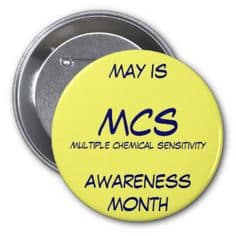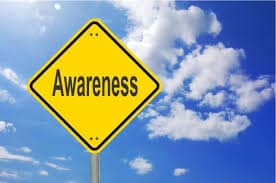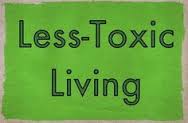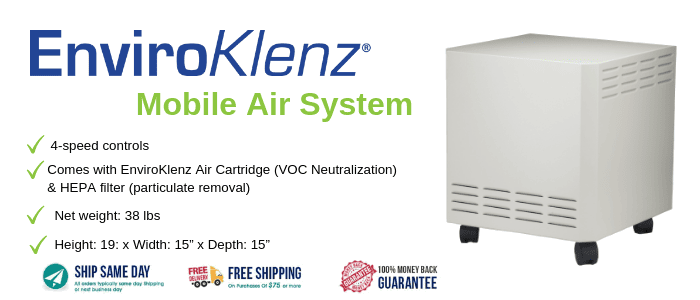Are You Aware of MCS?
 Multiple Chemical Sensitivity (MCS) is a condition where people experience symptoms of all kinds in response to toxic chemical exposures from everyday consumer products found in the home, office, and public environment.It is a phenomenon of the twentieth century, a result of the increase of consumer products made using toxic substances and materials.
Multiple Chemical Sensitivity (MCS) is a condition where people experience symptoms of all kinds in response to toxic chemical exposures from everyday consumer products found in the home, office, and public environment.It is a phenomenon of the twentieth century, a result of the increase of consumer products made using toxic substances and materials.
Symptoms range from slight to disabling. At it’s most extreme, “universal reactors” respond continuously to everything in their environment, whether toxic or benign.
Because people with MCS react to toxic chemicals in their surrounding environment, they need understanding and cooperation from neighbors and others in their communities. They need neighbors to not use fabric softener or BBQ lighter fluid because these easily move through the neighborhood on a breeze. They need fellow parishioners to not wear perfume so they can attend church services.
Even though MCS has been known to exist for more than 50 years, most people still are not aware of this condition, what causes it, how it can be prevented, or how they can help those who live with MCS every day.
A Long Road to Recognition
 MCS was first reported in the mid-1950s by Dr. Theron Randolph, an allergist who practiced in Chicago. He began to identify patients with the “petrochemical problem,” who complained of becoming ill when exposed to car exhaust, smoke from factories, and various products that contain ingredients derived from gas, oil, or coal. Dr. Randolph advised these patients to avoid chemical exposures to see if their condition improved. If so, they were to reintroduce the offending substances one by one to see if the symptoms reappeared.
MCS was first reported in the mid-1950s by Dr. Theron Randolph, an allergist who practiced in Chicago. He began to identify patients with the “petrochemical problem,” who complained of becoming ill when exposed to car exhaust, smoke from factories, and various products that contain ingredients derived from gas, oil, or coal. Dr. Randolph advised these patients to avoid chemical exposures to see if their condition improved. If so, they were to reintroduce the offending substances one by one to see if the symptoms reappeared.
At that time, the marketplace was being flooded with products made from new materials derived from petroleum and other petrochemicals that had not been used before. Brand new televisions ran DuPont’s cheery commercials proclaiming, “better living through chemistry.” In the 1960s, Rachel Carson wrote Silent Spring, the first book to expose the health and environmental effects of pesticides, while Dustin Hoffman was encouraged to go into the field of plastics in the movie “The Graduate.”
While a growing number of patients were being diagnosed with MCS and finding relief by avoiding toxic chemicals in consumer products as best they could, the medical community now had to come to terms with a condition they had never seen before and did not know how to treat. No drug or surgery could exist to treat MCS. Government agencies had to recognize MCS as an illness before they could approve financial aid for disabled sufferers.
The energy crisis of the 1970s also contributed to MCS. Prior to this, buildings were “leaky,” allowing air to escape through cracks and other small openings. This was good for allowing toxic fumes to escape but made it difficult for buildings to hold heating and cooling. To save energy, buildings were “tightened” by filling all holes and cracks. Suddenly indoor concentrations of toxic chemicals emitting from consumer products and building skyrocketed, creating the new field of Indoor Air Quality (IAQ). And more MCS.
 The first books about MCS weren’t written until the early 1980’s. Patient advocate Natalie Golos wrote the first book on how to live with MCS Coping With Your Allergies, and Debra Lynn Dadd wrote A Consumer Guide for the Chemically Sensitive, which identified the toxic chemicals those with MCS were reacting to, where they were found in consumer products, and how to find safe alternatives. Support groups began to form, as patients began to help each other with the difficulties of reacting to practically everything in the modern world.
The first books about MCS weren’t written until the early 1980’s. Patient advocate Natalie Golos wrote the first book on how to live with MCS Coping With Your Allergies, and Debra Lynn Dadd wrote A Consumer Guide for the Chemically Sensitive, which identified the toxic chemicals those with MCS were reacting to, where they were found in consumer products, and how to find safe alternatives. Support groups began to form, as patients began to help each other with the difficulties of reacting to practically everything in the modern world.
Up until this time, there wasn’t much awareness of MCS in the general population. And then, in 1988, the EPA installed 27,000 square yards of synthetic wall-to-wall carpet in their headquarters in Washington DC. More than 200 employees became ill. Some reported exactly the same symptoms as those with MCS.
Now awareness of MCS became widespread. In the mid-1990s, two top television shows—Northern Exposure and LA Law—created characters with MCS.
Over the years, MCS has become recognized as a disabling condition by
• the Department of Housing and Development (HUD)
• the Environmental Protection Agency (EPA
• the National Academy of Sciences.
MCS is considered a valid condition for workman’s compensation claims.The governors of many states have signed proclamations recognizing MCS. MCS has been accepted as a disabling illness by Social Security, with a diagnostic code of DI 24515.064.But there is still a long way to go.
For example, there is no International Classification of Diseases (ICD) code in the USA for the health condition of environmental illness. MCS is explicitly identified in the ICD codes of several European and countries and actions are underway to recognize it in the ICD codes of all European countries.And still, there are many online articles that discredit the validity of MCS entirely.
MCS Awareness
 Those with MCS are in a unique situation in that their well-being is very much influenced by the choices and actions of others.A person with MCS needs to live in an environment that does not contain toxic triggers that cause a reaction, which means for the most part they need to stay home in their protected space.At the very least, a person with MCS should be able to go out into the world and have others understand their needs and be willing to help. And so there needs to be education to build awareness.
Those with MCS are in a unique situation in that their well-being is very much influenced by the choices and actions of others.A person with MCS needs to live in an environment that does not contain toxic triggers that cause a reaction, which means for the most part they need to stay home in their protected space.At the very least, a person with MCS should be able to go out into the world and have others understand their needs and be willing to help. And so there needs to be education to build awareness.
May is MCS Awareness month when people with MCS all over the country make an effort to bring awareness of MCS to their own communities. The general public needs to know how they can help and accommodate those with MCS, But they also need to know that anyone can develop MCS from the exposures commonly found in American homes and offices.
And they need to know that MCS can be prevented. There is no need for any man, woman, or child of any age to develop MCS. All anyone needs to do is learn where the toxic exposures are in their lives and eliminate them.
We can end MCS entirely, by collectively creating environments in which we live, work, and play that are free from toxic exposures. And that would help everyone, everywhere.
What We Still Need to Improve
While MCS has become recognized over the years, there is still much that is misunderstood about the condition. First, regardless of the debates and disagreements in the medical community, there needs to be more awareness that MCS is a very real and disabling condition for many people.
In 2009, Professors Stanley Caress and Anne Steinemann published the results of their national prevalence study for MCS in The Journal of Environmental Health. In their national phone survey, 3.2 percent of the respondents said that they had been medically diagnosed with MCS. This result suggests that over ten million Americans are suffering from MCS. We’re not talking here about a small group of people in a minority. It’s like everyone in the entire state of North Carolina has MCS.
And there needs to be more awareness that the problem is not those who suffer from MCS, but rather the problem is the toxic environments so common in our modern world. Those with MCS are having a normal response to being poisoned with toxic chemicals. When those with MCS create living spaces that are free from toxic triggers, their reactions significantly lessen.
 What those with MCS need most is for the world to be less toxic. They need others to become aware of the common exposures that trigger reactions, like perfume and cigarette smoke, and for others to be considerate.If we all were to create a world where those with MCS could walk into a store to buy groceries without having a reaction, or could ride in a car without having a reaction, work in an office without requiring special considerations, eat in a restaurant, go to a movie, do everything everyone else does. If we could create a world that would be safe for them, it would be safe for everyone else too. And medical costs would be practically nothing.
What those with MCS need most is for the world to be less toxic. They need others to become aware of the common exposures that trigger reactions, like perfume and cigarette smoke, and for others to be considerate.If we all were to create a world where those with MCS could walk into a store to buy groceries without having a reaction, or could ride in a car without having a reaction, work in an office without requiring special considerations, eat in a restaurant, go to a movie, do everything everyone else does. If we could create a world that would be safe for them, it would be safe for everyone else too. And medical costs would be practically nothing.
When MCS was first observed, Dr. Randolph was looking at how the emerging toxic chemicals in consumer products were affecting the immune system. Now we know that these same toxic chemicals that create MCS and trigger reactions are the same toxins that cause cancer, birth defects, endocrine disruption, and more. Every symptom and illness have now been associated with exposure to toxic chemicals. There needs to be more awareness of this. Toxic chemicals are not just causing MCS for ten million Americans. They are causing every illness for everyone.
As difficult as it can be to live with MCS, it may be our greatest blessing. For those with MCS have brought awareness to the presence of toxic chemicals in our world and then need to create safe products for our own health and the health of generations to come.

The EnviroKlenz Mobile Air System is your solution to removing VOCs and chemical pollutants from your indoor environment. With the use of a hospital-grade HEPA filter and an effective earth mineral technology air cartridge, this two-stage filtration is perfect to place in your indoor space to mitigate potential hazards to your health. Whether you have chemical sensitivities, allergies, or are just looking to improve your indoor air quality, the EnviroKlenz Mobile Air System is your answer!
- Simple and Easy to Set-Up, with Minimal Maintenace
- Replace Air Cartridge every 4 to 6 Months
- HEPA Filter Replaced Every Two Years
- Quiet Operation, 4-Speed Motor
- No Chemical Odors Released!
We are confident that our EnviroKlenz Technology will drastically reduce the odors in your home, if it doesn’t live up to your expectations, we will issue a full refund within 30 days of your purchase!
Click below to buy NOW!
Hear What People Are Saying About Us…








